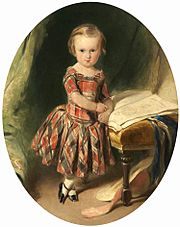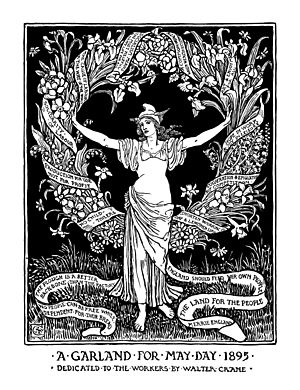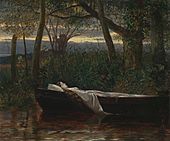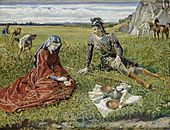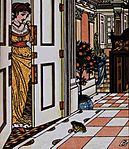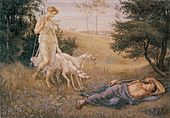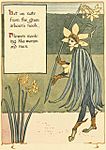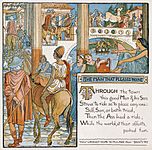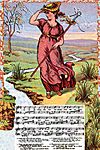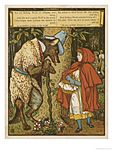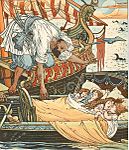Walter Crane facts for kids
Quick facts for kids
Walter Crane
|
|
|---|---|
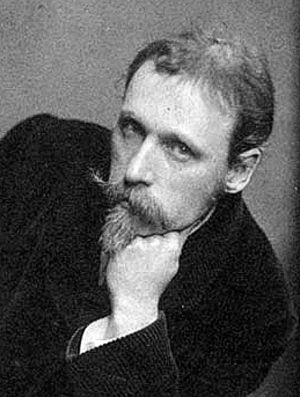
Walter Crane, c. 1886
|
|
| Born | 15 August 1845 Liverpool, Lancashire, England
|
| Died | 14 March 1915 (aged 69) Horsham, West Sussex, England
|
| Nationality | British |
| Known for | Children's literature |
| Awards | Albert Medal (1904) |
Walter Crane (born August 15, 1845 – died March 14, 1915) was a famous British artist and book illustrator. He is known as one of the most important and active creators of children's books during his time. Along with Randolph Caldecott and Kate Greenaway, he helped shape how English children's books looked in the late 1800s.
Crane's art often showed colorful and detailed scenes of children in gardens. These images became very popular in nursery rhymes and children's stories for many years. He was also a key part of the Arts and Crafts movement, which focused on beautiful, handmade items. Crane created many different types of art, including paintings, illustrations, children's books, ceramic tiles, and other decorative pieces. He is also remembered for designing well-known symbols for the international Socialist movement.
Contents
Walter Crane's Life Story
His Early Life and Artistic Inspirations
Walter Crane was the second son of Thomas Crane, who was a portrait painter. His mother was Marie Crane. Walter's older brother, Thomas, also became an illustrator, and his sister, Lucy, was a well-known writer.
Walter was very interested in new art styles. He carefully studied the detailed and colorful art of the Pre-Raphaelite Brotherhood, a group of artists who liked art from before the Renaissance. He also learned a lot from the famous artist and critic John Ruskin.
When he was young, Walter designed some colored pages for a poem called "The Lady of Shalott" by Tennyson. These designs impressed a wood-engraver named William James Linton. Walter then worked as Linton's apprentice from 1859 to 1862. This job gave him a great chance to study the work of other artists closely, like the Pre-Raphaelites Dante Gabriel Rossetti and John Everett Millais. He also admired Sir John Tenniel, who illustrated Alice's Adventures in Wonderland.
Crane was inspired by the old masters of the Italian Renaissance. However, he was even more influenced by the ancient Greek sculptures called the Elgin marbles at the British Museum. Another important influence on his art was studying Japanese color-prints. He copied their style in a series of toy books, which became very popular and started a new trend.
His Involvement in Social Causes
Starting in the early 1880s, Walter Crane became very involved with the Socialist movement. He was especially influenced by his friend William Morris. Crane, like Morris, wanted to bring beautiful art into everyone's daily lives, not just the wealthy.
To achieve this, he designed many textiles and wallpapers, and also worked on house decorations. But he also used his art to directly support the Socialist cause. For a long time, he drew weekly cartoons for Socialist newspapers like Justice, Commonweal, and The Clarion. Many of these drawings were later collected in a book called Cartoons for the Cause.
Crane spent a lot of time working with the Art Workers Guild, where he was a leader in 1888 and 1889. He also helped start the Arts and Crafts Exhibition Society in 1888. He was also a Vice President of the Healthy and Artistic Dress Union, which started in 1890. This group wanted to encourage people to wear loose, comfortable clothing instead of stiff, tight, or heavy clothes. They even published pamphlets, including one called "How to Dress Without a Corset," which Crane illustrated.
Although Crane was not an anarchist himself, he contributed to some publishers who supported libertarian ideas. He is also known for designing the front of "The Bomb Shop," a bookshop that specialized in left-wing and radical books.
Crane caused some controversy when he supported four Chicago anarchists who were executed in 1887. These individuals were linked to the Haymarket affair, a bombing incident. When Crane visited the United States in 1891 for an art exhibition, he spoke at an anarchist meeting in Boston. He shared his belief that the Haymarket defendants had been wrongly put to death. This upset many people in polite society.
After his comments, Crane found a letter saying he would face "hopeless ruin" among American art supporters. Financial help was stopped, and planned dinners in his honor were canceled. Crane wrote to the press to explain that he didn't mean to offend anyone and didn't support violence. He simply believed the convicted individuals were innocent of the crime they were charged with. This event was called "probably the most dramatic episode" in his career by the newspapers.
His Later Years and Passing
Walter Crane passed away on March 14, 1915, at Horsham Hospital in West Sussex. His body was cremated, and his ashes are kept at the Golders Green Crematorium. He was survived by his three children: Beatrice, Lionel, and Lancelot.
Walter Crane's Artistic Creations
His Paintings and Illustrations

In 1862, Walter Crane's painting The Lady of Shalott was shown at the Royal Academy of Arts. However, the Academy often rejected his later, more developed works. After the Grosvenor Gallery opened in 1877, he stopped sending his paintings to the Royal Academy.
In 1863, a printer named Edmund Evans hired Crane to illustrate cheap paperbacks. In 1865, they started working together on toy books filled with nursery rhymes and fairy tales. From 1865 to 1876, Crane and Evans created two to three toy books every year.
Here are some of his famous illustration series: In 1864, he began illustrating a series of inexpensive nursery rhyme toy books in three colors for Edmund Evans. He had more artistic freedom in a series that started with The Frog Prince (1874). These books clearly showed the influence of Japanese art and his long visit to Italy after he got married in 1871. His work was known for its clear outlines and flat colors.
The Baby's Opera, a book of English nursery songs, was released in 1877 with Evans. He also created a third series of children's books called Romance of the Three R's, which taught art to young children. In his early work "Lady of Shalott," Crane showed his interest in making book designs unified. He even printed the words of the poem himself, believing that combining writing and decoration was the secret to the beauty of old illuminated books.
He followed this idea in The First of May: A Fairy Masque by his friend John Wise. In this book, both the text and decorations were reproduced using a special printing method. The "Goose Girl" illustration from his beautiful Household Stories from Grimm (1882) was later made into a large watercolour painting and then into a tapestry by William Morris.
Flora's Feast, A Masque of Flowers featured lithographic copies of Crane's drawings that were colored with watercolor. He also added color to The Wonder Book by Nathaniel Hawthorne and Margaret Deland's Old Garden. In the 1880s and 1890s, he illustrated 16 children's novels by Mrs. Molesworth using black and white drawings.
In 1894, he worked with William Morris on the page decorations for The Story of the Glittering Plain. This book, published by the Kelmscott Press, was designed in the style of 16th-century Italian and German woodcuts. Crane also illustrated editions of Edmund Spenser's The Faerie Queene and The Shepheard's Calendar. Other books he illustrated include Ali Baba and the Forty Thieves (1873), The Happy Prince and Other Stories by Oscar Wilde (1888), an edition of Arthurian Legends, A Flower Wedding, and in 1900, Judge Perry's retelling of Cervantes's Don Quixote of the Mancha.
Crane also wrote and illustrated three books of poetry himself: Queen Summer (1891), Renascence (1891), and The Sirens Three (1886). He also illustrated Nellie Dale's books for teaching English reading, which were likely completed between 1898 and 1907.
His Mature and Decorative Work
Crane's own paintings, which were mostly allegorical (meaning they used symbols to represent ideas), included The Bridge of Life (1884) and The Mower (1891). These were regularly shown at the Grosvenor Gallery and later at the New Gallery. Neptune's Horses was shown in 1893, and his Rainbow and the Wave is similar in style.
His diverse work also included plaster reliefs, tiles, stained glass, pottery, wallpaper, and textile designs. In all his decorative work, he believed that artists work best when they don't directly copy nature. Instead, they should know the forms they use by heart.
An exhibition of his various works was held in London in 1891 and then traveled to the United States that same year. It was later shown in Germany, Austria, and Scandinavia.
Crane became a member of the Royal Institute of Painters in Water Colours in 1882, though he resigned in 1886. Two years later, he joined the Water Colour Society (1888). He also worked as an examiner for the Science and Art Department at the South Kensington Museum. He was the director of design at the Manchester Municipal School (1894), art director of Reading College (1896), and for a short time in 1898, the principal of the Royal College of Art. There, he planned a new way of teaching that would help students work more closely with tools and materials.
His lectures at Manchester were published with drawings as The Bases of Design (1898) and Line and Form (1900). His book The Decorative Illustration of Books, Old and New (2nd ed., 1900) also added to his ideas about art. A well-known portrait of Crane by George Frederick Watts was shown in 1893.
In 1887, Emilie Barrington asked Crane to paint a series of murals for the new Red Cross Hall in Southwark. This project was started by housing activist Octavia Hill. Crane created designs for nine large panels, which were shown at the 1890 Arts and Crafts Exhibition Society show. However, only three of these designs were made into full-size murals: Alice Ayres (1890), which showed a heroine from a fire in 1885; Jamieson (1892), showing two Scottish railway workers who died in 1874; and Rescue from a Well (1894), showing George Eales, a laborer who rescued a child from a well in 1887. After 1894, no more murals were created, partly because of a lack of money and other commitments. Also, it was found that the gas lighting in the hall was damaging the paintings. The Red Cross Hall is now privately owned, and the condition of the murals is not known.
A large mosaic called "The Sphere and Message of Art," designed by Crane, was planned for the front of the Whitechapel Art Gallery when it was built in 1898. Unfortunately, there wasn't enough money, so the front was covered with plain tiles instead. The original drawing for the mosaic still exists.
One of Crane's last major works was the lunettes (arch-shaped paintings) he created at the Royal West of England Academy in 1913.
Gallery
-
The Lady of Shalott,
oil on canvas, 1862 -
"The Frog asks to be allowed to enter the Castle", illustration for The Frog Prince, 1874 -
Diana and Endymion, watercolour and gouache, 1883 -
King Midas with his daughter, from Nathaniel Hawthorne's 1893 edition of A Wonder-Book for Girls and Boys -
Illustration for The Man That Pleased None from Baby's Own Aesop, an 1887 children's edition of Aesop's fables -
Illustration for Little Bo Peep, c. 1885 -
"Little Red Riding Hood Meets the Wolf in the Woods" -
"The children of Queen Blondine and sister Brunette picked up by a Corsair", from the fairy tale Princess Belle-Etoile, 1884 -
Comic-like illustration for "Puss in Boots" from The Marquis of Carabas' Picture Book
Works by Walter Crane
- An Artist's Reminiscences. New York: Macmillan, 1907.
See also
 In Spanish: Walter Crane para niños
In Spanish: Walter Crane para niños


